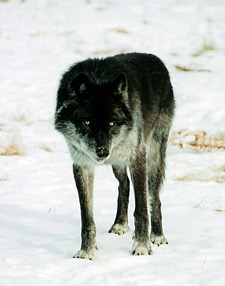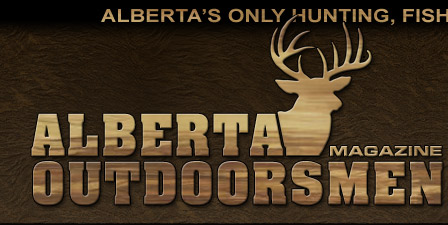|
 |
 |
Few predators invoke human emotions as does the gray wolf. Better known in Alberta as the timber wolf, conservationists and animal-rights activists—often one in the same—complain bitterly when wildlife agencies set management goals that call for the elimination of wolves.
Remember the aerial wolf control program for the removal of wolves that preyed on the Little Smoky caribou herd? The helicopter gunning of wolves brought with it a stream of complaints with conservationists bemoaning the program, suggesting that wolves were innocent and that the program was little more than a “war against wolves” using helicopter gunships and search and destroy techniques.
The vast majority of North American society has been brought up on the belief that wolves have been needlessly persecuted by man; that they are harmless; after all, famous Canadian author Farley Mowat and his film “Never Cry Wolf” proved so... didn’t it?
But for the most part there has been good reason for wolf control programs around the world.
 |
| Throughout history the wolf has demonstrated an ability to survive that is matched only by the coyote. |
And the wolf today is almost as prolific as the coyote, a “continental survivor” if you will, capable of withstanding even the most ardent of control programs. And as such, conservationists complain that wolf control via poisoning or aerial gunning is ineffective and irresponsible, suggesting that these programs are little more than a waste of time and money as the targeted population will, in short order, rebound. However, I will leave that debate up to wildlife managers and conservationists who are at odds with methods used for controlling wolves. I would like to take a look at the relationship between man and wolves, where it has been, where it currently sits, and where it is headed here in Alberta.
When fur trader Anthony Henday first set foot on Alberta soil back in 1754 he wrote in his diary, “I cannot say whether them (wolves) or the buffalo are more numerous.” Of course it is believed that buffalo numbers would have far exceeded those of Canis lupus but even a mentioning of wolf numbers by Henday and later by other fur trader-explorers as being “abundant”, leaves us with no other conclusion.
In fact; around 1865 the Reverend John McDougall also described abundant numbers of wolves preying on bison hunter’s horses and Natives also reported outbreaks of rabies in wolves around that same period. Wolves were indeed a big part of Alberta’s landscape.
Then, as buffalo numbers began to fall, so did those of the wolf. Market hunters and settlers also began to take a toll on ungulate numbers further reducing the wolf population as a lack of game made it harder for the wolf to survive. And then, the practice of poisoning wolves at carcasses—known as “wolfing”—by fur traders (wolfers) also took huge numbers of wolves.
But the extermination of wolves, namely in southern Alberta, was looked upon as a blessing. European settlers had come to Alberta with a history of stories involving the evil wolf, including Little Red Riding Hood—a story born from real experiences. In many parts of Europe and Asia where the disarming of its citizens was common practice, history shows us that wolves were indeed a serious concern among the populace.
As written by Valerius Geist, Professor Emeritus, University of Calgary in his wonderful three-part series published in Boone & Crockett’s Fair Chase Magazine, “Large Predators: Them and Us!”—“Compared to bears, wolves were hated—with excellent reason. Not only did they destroy livestock in the fields, but they found means and ways to break into stables in villages and kill the precious family cow or sheep thought to be safely stabled indoors. Children were a primary target of wolves. Rabies was not uncommon, and a rabid wolf running amuck biting horses, cattle, and people in rapid succession was a death angel if there ever was one!”
At the time there was no vaccination for rabies, if you were bit by a rabid wolf, you died.
So it is easy to see how early settlers to Alberta would have feared the wolf. And Alberta’s wolves are known to be some of the largest in the world with adult males weighing an average of 110-pounds, having keen eyesight, smell and hearing, and massive canines. A formidable foe at least and one not easily suppressed. Despite all attempts to exterminate the wolf, it still managed to survive.
In 1899 a bounty was placed on southern Alberta’s wolves by the Western Stock Growers’ Association and nearly 3000 dead wolves were paid for by 1907. That same year a province-wide bounty was placed on the wolf and by 1922 the last wolf had been removed from Waterton Lakes National Park because of livestock predation in surrounding areas. The wolf was finally starting to succumb to the pressures put upon it.
But by the late 1940s the North American model of wildlife conservation was starting to pay dividends. Populations of elk, deer and moose were making good comebacks and along with this renewed source of prey the wolf was also laying claim to old territories.
However, by the mid 1950s wolves were once again being targeted. An outbreak of rabies, depredation of livestock and the concern of wildlife managers about the loss of ungulates to wolves led to Alberta’s veterinary service declaring the wolf public enemy number one—thousands of wolves were then killed by poisoning and only an estimated 500 to 1000 wolves were believed to exist in Alberta by the end of the 1950s, early 1960s.
From this point forward, short of smaller wolf management campaigns, the gray wolf was left much to its own and by the 1970s their numbers had rebounded dramatically with an estimated population of between 4000 and 5000. A compensation program for livestock owners was initiated in 1974 and wolf diseases were now being monitored.
But complaints were still coming in—predation of livestock was rising astronomically and hunters were once again complaining of too many wolves and too few ungulates. But management plans were now being scrutinized by conservation groups that had adopted the wolf as an iconic species and governments were shy to react to complaints and when they did, they were greeted by public outcry and intervention by conservation groups.
And wolves took advantage with increased livestock kills and a new brazen attitude towards rancher's pets—an easy source of food. Moose populations had crashed from tick infestations and wolves feasted, leading to another resurgence in wolf populations. Life was good for Canis lupus.
Alberta government statistics (2002) show that from 1972 to 1990 there were more than 2800 complaints regarding wolf harassment and predation, approximately 160 per year, of which 73% were related to cattle, 7% pets, 6% horses and 5% sheep, with the remaining numbers involving other animals including poultry.
Unlike other provinces, much of Alberta's landscape is forest-agriculture fringe—our eastern slopes gives way to rolling ranch lands that host large numbers of grazing cattle and other domestics—and it is this landscape that offers the wolf an opportunity to execute its foremost talent, predation and escape.
Since 1974, when Alberta first initiated its Wildlife Predator Compensation Program, several million dollars has been paid out to farmers and ranchers for livestock losses, of which a large sum is accountable to the wolf.
And with wolf harvest rates well below necessary levels, despite government sponsored wolf trapping courses, extended hunting and trapping seasons and no bag limits, Alberta's wolf population is enjoying the fine life at the expense of a fish and wildlife budget that would be better suited funding other projects.
And with conservationists watching government control initiatives, and the threat of public outcry constantly looming overhead, Alberta's wolves are excelling.
Next month we will look at what is being done to provide relief to Alberta's farmers and ranchers and what hunters and trappers are doing, and can do, to minimize the problems associated with Alberta's burgeoning wolf population. ■
For previous Outdoor Pursuits click here.
|
|
|
|


